As reviewers, we eagerly anticipate reading the early releases in the new year. The books that we review in this week’s column suggest that 2018 will be another terrific year for children’s and young adult literature and that readers can look forward to a year of great books from which to choose. Happy reading to all in 2018!
Ages 4–8
Girl Running: Bobbi Gibb and the Boston Marathon. Annette Bay Pimentel. Ill. Micha Archer. 2018. Nancy Paulsen/Penguin.
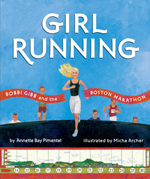 Bobbi Gibb loved to run, and she was fast. After watching the Boston Marathon one year, she begins serious long-distance training. Her requests for an application to participate in the Boston Marathon, however, is rejected. Organizers respond, “Women are not physiologically able to run 26 miles and furthermore the rules do not allow it.” Determined to prove them wrong, Bobbi does run the Boston Marathon by hiding near the starting line and sneaking onto the course to join the racers. Rules being rules, she finishes unofficially. “Bobbi’s first race is over, but marathoning for women has begun.” The inclusion of a border of the route with mile markers and elevation indicators along the bottom of the colorful illustrations highlights the difficulty of the race. Back matter includes an afterword on Gibb’s 1966 race and the Boston Marathon and a bibliography.
Bobbi Gibb loved to run, and she was fast. After watching the Boston Marathon one year, she begins serious long-distance training. Her requests for an application to participate in the Boston Marathon, however, is rejected. Organizers respond, “Women are not physiologically able to run 26 miles and furthermore the rules do not allow it.” Determined to prove them wrong, Bobbi does run the Boston Marathon by hiding near the starting line and sneaking onto the course to join the racers. Rules being rules, she finishes unofficially. “Bobbi’s first race is over, but marathoning for women has begun.” The inclusion of a border of the route with mile markers and elevation indicators along the bottom of the colorful illustrations highlights the difficulty of the race. Back matter includes an afterword on Gibb’s 1966 race and the Boston Marathon and a bibliography.
—CA
I Am a Cat. Galia Bernstein. 2018. Abrams.
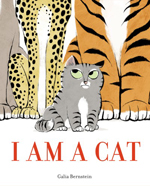 A green-eyed domestic cat introduces himself to Lion, Puma, Panther, Tiger, and Cheetah saying, “Hello, my name is Simon. I am a cat. Just like you!” They all laugh at Simon and point out that he can’t be a cat because he is nothing like them. Tiger even labels him a small, gray rat. Definitely not a cat. In turn, the big cats describe their special characteristics (spots, stripes, or a mane; roaring; living in jungles). When Simon questions what makes them cats since they are all so different, Lion points out what they have in common (small, perky ears, flat noses, long whiskers and tails, sharp teeth and claws, and night-vision eyes), and Simon protests, “I have all of those things. Only smaller.” Finally, all the big cats agree with him, and Simon spends the day with his new family “pouncing and prowling, prancing and playing, like cats of all sizes do.” Bernstein’s artwork (created digitally with applied hand-painted textures) boldly portrays the characteristics of the members of the Felidae family in this picture book, which is a good read-aloud choice.
A green-eyed domestic cat introduces himself to Lion, Puma, Panther, Tiger, and Cheetah saying, “Hello, my name is Simon. I am a cat. Just like you!” They all laugh at Simon and point out that he can’t be a cat because he is nothing like them. Tiger even labels him a small, gray rat. Definitely not a cat. In turn, the big cats describe their special characteristics (spots, stripes, or a mane; roaring; living in jungles). When Simon questions what makes them cats since they are all so different, Lion points out what they have in common (small, perky ears, flat noses, long whiskers and tails, sharp teeth and claws, and night-vision eyes), and Simon protests, “I have all of those things. Only smaller.” Finally, all the big cats agree with him, and Simon spends the day with his new family “pouncing and prowling, prancing and playing, like cats of all sizes do.” Bernstein’s artwork (created digitally with applied hand-painted textures) boldly portrays the characteristics of the members of the Felidae family in this picture book, which is a good read-aloud choice.
—NB
One Fun Day with Lewis Carroll: A Celebration of Wordplay and a Girl Named Alice. Kathleen Krull. Ill. Júlia Sardà, 2018. Houghton Mifflin Harcourt.
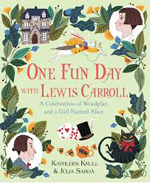 Lewis Carroll was an expert at making any day “frabjous.” Once, while boating on the river, he told a girl named Alice a tale about a girl named Alice who tumbles down a rabbit hole. Kathleen Krull peppers her text with Carroll’s nonsense words and phrases, such as “slithy” (a combination of slimy and lithe), “realing and writhing” (a variation on the subjects of reading and writing) and “un-birthday” (any day other than one’s birthday).All the words and ideas invented or adapted by Carroll are color coded in the text to indicate the source—Alice’s Adventures in Wonderland, Through the Looking-Glass, and What Alice Found There, or The Hunting of the Snark—and defined in a glossary. Júlia Sardà’s whimsical double-page illustrations playfully mix real people and fictional characters, such as the White Rabbit, the Mock Turtle, and the Lobster Quadrille. One Fun Day with Lewis Carroll is the perfect picture book for encouraging children to read Carroll’s fantasies, to incorporate some of his language into their conversations, and perhaps to coin some words on their own.
Lewis Carroll was an expert at making any day “frabjous.” Once, while boating on the river, he told a girl named Alice a tale about a girl named Alice who tumbles down a rabbit hole. Kathleen Krull peppers her text with Carroll’s nonsense words and phrases, such as “slithy” (a combination of slimy and lithe), “realing and writhing” (a variation on the subjects of reading and writing) and “un-birthday” (any day other than one’s birthday).All the words and ideas invented or adapted by Carroll are color coded in the text to indicate the source—Alice’s Adventures in Wonderland, Through the Looking-Glass, and What Alice Found There, or The Hunting of the Snark—and defined in a glossary. Júlia Sardà’s whimsical double-page illustrations playfully mix real people and fictional characters, such as the White Rabbit, the Mock Turtle, and the Lobster Quadrille. One Fun Day with Lewis Carroll is the perfect picture book for encouraging children to read Carroll’s fantasies, to incorporate some of his language into their conversations, and perhaps to coin some words on their own.
—CA
When Sophie Thinks She Can’t . . . Molly Bang. 2018. Blue Sky/Scholastic.
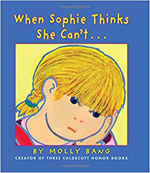 After Sophie can’t complete a tangram at home, she thinks, “I can’t do ANYTHING!” Even after her teacher talks to the class about exercising their brains to become smarter by doing math puzzles, Sophie thinks she can’t—until her teacher says, “You haven’t figured it out … YET… Keep trying, and you will.” Finally solving the puzzle, Sophie realizes, “I did it! I can do it again!” Back home, she shares the magical word “YET” with her frustrated father, and they fix a stubborn cabinet door together. Double-page, brightly colored illustrations, outlined in thick primary colors, complement the story's positive message. Front matter includes information about tangrams, and back matter describes growth mindset teaching, a technique teachers can use to help students master new learning. Young children will also enjoy Bang’s two other books about young Sophie: When Sophie Gets Angry—Really, Really Angry . . . (1999) and When Sophie’s Feelings Are Really, Really Hurt (2015).
After Sophie can’t complete a tangram at home, she thinks, “I can’t do ANYTHING!” Even after her teacher talks to the class about exercising their brains to become smarter by doing math puzzles, Sophie thinks she can’t—until her teacher says, “You haven’t figured it out … YET… Keep trying, and you will.” Finally solving the puzzle, Sophie realizes, “I did it! I can do it again!” Back home, she shares the magical word “YET” with her frustrated father, and they fix a stubborn cabinet door together. Double-page, brightly colored illustrations, outlined in thick primary colors, complement the story's positive message. Front matter includes information about tangrams, and back matter describes growth mindset teaching, a technique teachers can use to help students master new learning. Young children will also enjoy Bang’s two other books about young Sophie: When Sophie Gets Angry—Really, Really Angry . . . (1999) and When Sophie’s Feelings Are Really, Really Hurt (2015).
—NB
Ages 9–11
Blacksmith’s Song. Elizabeth Van Steenwyk. Ill. Anna Rich. 2018. Peachtree.
 In this imagined history picture book, set during the days of the Underground Railroad, Pa (a blacksmith and slave) hammers out rhythmic cryptic messages daily to runaway slaves while also awaiting the signal for him and his family to join the travelers. One morning, Pa becomes ill and can’t go to work. His 9-year-old son, who has been secretly practicing, takes on the responsibility of pounding out the “blacksmith’s song” until, at last, it is time for them to leave, too. Somber, muted oil paintings complement this emotionally charged storyline. Back matter provides a note on the inspiration for the story as well as historical background.
In this imagined history picture book, set during the days of the Underground Railroad, Pa (a blacksmith and slave) hammers out rhythmic cryptic messages daily to runaway slaves while also awaiting the signal for him and his family to join the travelers. One morning, Pa becomes ill and can’t go to work. His 9-year-old son, who has been secretly practicing, takes on the responsibility of pounding out the “blacksmith’s song” until, at last, it is time for them to leave, too. Somber, muted oil paintings complement this emotionally charged storyline. Back matter provides a note on the inspiration for the story as well as historical background.
—NB
The Serpent’s Secret (Kiranmala and the Kingdom Beyond #1). Sayantani DasGupta. 2018. Scholastic.
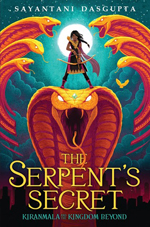 On Kiranmala’s 12th birthday, her overprotective parents vanish, a rakkhosh demon attacker her New Jersey home and tries to eat her, and she discovers she is an interdimensional Indian princess thrust into a hero’s journey to save her family. Rescued from the rakkhosh by two princes and whisked away to a fantastical dimension where she meets birth parents she never knew about (the Moon Queen and the Serpent King), Kiran uncovers unknown magic within herself to use in fighting enemies she encounters. Kiran’s quirky first-person narration will sweep readers into one near-death adventure after another as she works to save the beloved mother and father of her childhood. An author’s note describes Indian folktales and stories referenced in this new series.
On Kiranmala’s 12th birthday, her overprotective parents vanish, a rakkhosh demon attacker her New Jersey home and tries to eat her, and she discovers she is an interdimensional Indian princess thrust into a hero’s journey to save her family. Rescued from the rakkhosh by two princes and whisked away to a fantastical dimension where she meets birth parents she never knew about (the Moon Queen and the Serpent King), Kiran uncovers unknown magic within herself to use in fighting enemies she encounters. Kiran’s quirky first-person narration will sweep readers into one near-death adventure after another as she works to save the beloved mother and father of her childhood. An author’s note describes Indian folktales and stories referenced in this new series.
—NB
Ages 12–14
Facing Frederick: The Life of Frederick Douglass, a Monumental American Man. Tonya Bolden. 2018. Abrams.
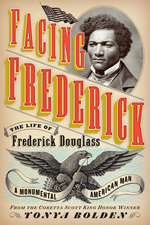 In this well-researched biography, Tonya Bolden chronicles the life and accomplishments of Frederick Douglass (1818–1895), focusing on decisions that shaped his life and the history of the United States. In her engaging and accessible narration, Bolden clearly communicates how Douglass used his personal experiences with slavery and racism—what he called the “twin-monsters of darkness”—to enhance his effectiveness as a voice for the anti-slavery movement and the rights for black people and women. A wealth of quotes and captioned archival photographs, drawings, and documents and insets of quotes contribute to the readers understanding of Frederick Douglass, a writer, orator, abolitionist, suffragist, statesman, diplomat—“a monumental American man.” Back matter includes an author’s note, timeline, source notes on quotations, selected sources, image credits, and index.
In this well-researched biography, Tonya Bolden chronicles the life and accomplishments of Frederick Douglass (1818–1895), focusing on decisions that shaped his life and the history of the United States. In her engaging and accessible narration, Bolden clearly communicates how Douglass used his personal experiences with slavery and racism—what he called the “twin-monsters of darkness”—to enhance his effectiveness as a voice for the anti-slavery movement and the rights for black people and women. A wealth of quotes and captioned archival photographs, drawings, and documents and insets of quotes contribute to the readers understanding of Frederick Douglass, a writer, orator, abolitionist, suffragist, statesman, diplomat—“a monumental American man.” Back matter includes an author’s note, timeline, source notes on quotations, selected sources, image credits, and index.
—CA
Martin Rising: Requiem for a King. Andrea Davis Pinkney. Ill. Brian Pinkney. 2018. Scholastic.
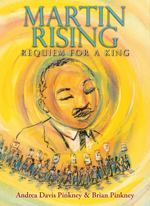 Andrea Davis Pinkney’s lyrical poetry and Brian Pinkney’s stunning impressionistic illustrations create a moving “requiem” for Martin Luther King, Jr., which focuses on the final months of his life, from a family celebration of his 39th birthday on January 15, 1968, to his assassination on April 4 in Memphis, Tennessee, where he had been speaking and leading rallies and marches in support of the garbage collector’s strike against the city’s discriminatory pay policy. The final poem, “Rejoice the Legacy” ends with “Can a Dream ever die? / A burst of sun replies: / His life well lived for peace and good. / Martin’s spirit—still alive! / And with love, we all shall rise,” an expressive reminder of why we celebrate Martin Luther King Day each year on January 15. Back matter includes reflections by the author and the illustrator on their creation of Martin Rising, a “Now Is the Time” section providing historical context, a time line, and a bibliography.
Andrea Davis Pinkney’s lyrical poetry and Brian Pinkney’s stunning impressionistic illustrations create a moving “requiem” for Martin Luther King, Jr., which focuses on the final months of his life, from a family celebration of his 39th birthday on January 15, 1968, to his assassination on April 4 in Memphis, Tennessee, where he had been speaking and leading rallies and marches in support of the garbage collector’s strike against the city’s discriminatory pay policy. The final poem, “Rejoice the Legacy” ends with “Can a Dream ever die? / A burst of sun replies: / His life well lived for peace and good. / Martin’s spirit—still alive! / And with love, we all shall rise,” an expressive reminder of why we celebrate Martin Luther King Day each year on January 15. Back matter includes reflections by the author and the illustrator on their creation of Martin Rising, a “Now Is the Time” section providing historical context, a time line, and a bibliography.
—CA
Ages 15+
A Land of Permanent Goodbyes. Atia Abawi. 2018. Philomel/Penguin.
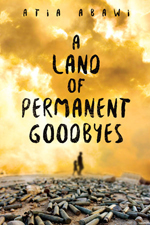 Teenager Tareq and the remaining members of his once-large family, consisting now of only his father, cousin, and 5-year-old sister, run for their lives from their war-torn country after their neighborhood is bombed in the ongoing Syrian conflict. Tareq grows up quickly as horrifying events befall him and his family: being threatened by Daesh fighters as they escape from Syria to Turkey and witness a public beheading; being separated from family members during the flight; surviving a treacherous raft trip from Turkey to Greece, in which many perish; the kidnapping of his sister; and fearing for the lives of his family at every turn of their traumatic escape. Tareq learns that although many of his countrymen put money above humanity, “helpers” from many countries stand in the gap to help them survive. Abawi, a foreign news correspondent, born a refugee in West Germany to Afghan parents fleeing a brutal war, brings insight and sensitivity to the plight of the refugee through the authentic storyline and the reflections of “Destiny,” who serves as the omniscient narrator. A glossary is included.
Teenager Tareq and the remaining members of his once-large family, consisting now of only his father, cousin, and 5-year-old sister, run for their lives from their war-torn country after their neighborhood is bombed in the ongoing Syrian conflict. Tareq grows up quickly as horrifying events befall him and his family: being threatened by Daesh fighters as they escape from Syria to Turkey and witness a public beheading; being separated from family members during the flight; surviving a treacherous raft trip from Turkey to Greece, in which many perish; the kidnapping of his sister; and fearing for the lives of his family at every turn of their traumatic escape. Tareq learns that although many of his countrymen put money above humanity, “helpers” from many countries stand in the gap to help them survive. Abawi, a foreign news correspondent, born a refugee in West Germany to Afghan parents fleeing a brutal war, brings insight and sensitivity to the plight of the refugee through the authentic storyline and the reflections of “Destiny,” who serves as the omniscient narrator. A glossary is included.
—NB
Votes for Women!: American Suffragists and the Battle for the Ballot. Winifred Conkling. 2018. Algonquin.
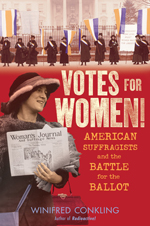 With a strong storytelling voice, Winifred Conkling offers readers a captivating account of the long-fought battle for women’s suffrage in the United States. Drawing from letter, journals, speeches, newspaper articles, and documents, Conkling focuses on the compelling personal stories of leaders in the suffrage movement—from Elizabeth Cady Stanton and Susan B. Anthony to Carrie Chapman Catt and Alice Paul—and key events—from the 1848 Woman’s Rights Convention in Seneca Falls, New York, to the ratification of the 19th Amendment to the U.S. Constitution in 1920. Back matter includes an “In Her Own Words” section on key primary sources, a time line, a bibliography, chapter-by-chapter notes on quotations, and an index. Votes for Women! is an important, inspiring, and timely book.
With a strong storytelling voice, Winifred Conkling offers readers a captivating account of the long-fought battle for women’s suffrage in the United States. Drawing from letter, journals, speeches, newspaper articles, and documents, Conkling focuses on the compelling personal stories of leaders in the suffrage movement—from Elizabeth Cady Stanton and Susan B. Anthony to Carrie Chapman Catt and Alice Paul—and key events—from the 1848 Woman’s Rights Convention in Seneca Falls, New York, to the ratification of the 19th Amendment to the U.S. Constitution in 1920. Back matter includes an “In Her Own Words” section on key primary sources, a time line, a bibliography, chapter-by-chapter notes on quotations, and an index. Votes for Women! is an important, inspiring, and timely book.
—CA
Nancy Brashear is Professor Emeritus of English from Azusa Pacific University, in Azusa, California. Carolyn Angus is former Director of the George G. Stone Center for Children's Books, Claremont Graduate University, in Claremont, California.
These reviews are submitted by members of the International Literacy Association's Children's Literature and Reading Special Interest Group (CL/R SIG) and are published weekly on Literacy Daily.